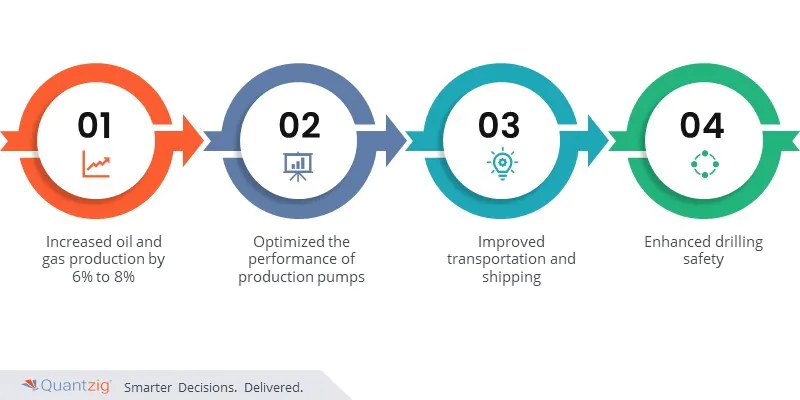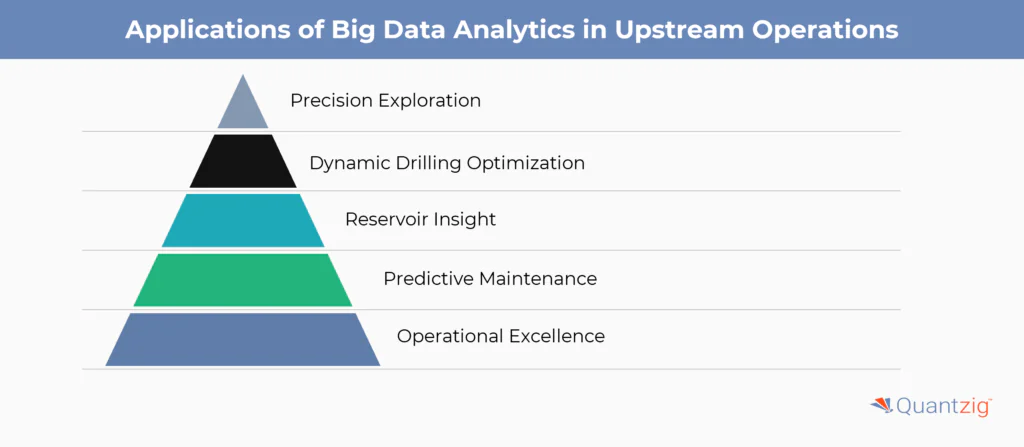Written By: Sudeshna Ghosh
Table of Contents
Introduction to Big Data in Oil and Gas
The integration of big data analytics has profoundly transformed the oil and gas sector, providing unparalleled insights across exploration, production, and distribution processes. In an industry where efficiency, safety, and optimization are paramount, the integration of big data analytics has become indispensable. From exploration through drilling, production, refining, and distribution, this integration spans the entire spectrum of operations, driving enhanced operational efficiency and maximizing returns on investment.
Quantzig’s big data analytics solution dashboard for the oil and gas industry offers a comprehensive solution tailored to the sector’s unique challenges and opportunities. With real-time data visualization and advanced analytics capabilities, it empowers oil and gas companies to extract actionable insights, optimize operations, and drive informed decision-making for enhanced efficiency and profitability.
Request a demo to experience the meaningful insights we derive from data through our big data analytical tools and platform capabilities. Schedule a demo today!
Request a Free DemoQuantzig’s Success Story
Highlights of the Case Study:
| Particulars | Description |
| Client | A major global oil and gas firm with a US presence wanted to embrace analytics and digitalization to explore new market opportunities. |
| Business Challenge | The client wanted to use advanced analytics to enhance operations throughout the value chain, including exploration, production, processing, retail, and essential back-office tasks. |
| Impact | Quantzig assisted the client in effectively streamlining oil and gas transport, processing, and distribution by deploying a cutting-edge big data analytics solution. |
The Challenges of the Manufacturing Client
A major global oil and gas firm, prominent in the US, collaborated with Quantzig to embrace analytics and digitalization, aiming to discover new market opportunities. The client sought to adopt a digital platform to analyze and manage its oil & gas operations, utilizing advanced analytics to optimize operations across the value chain, encompassing exploration, production, processing, retail, and essential back-office tasks. The client’s goal was to develop roadmaps for digital transformation, constructing and managing new tech stacks and platforms supporting their top business priorities in advanced analytics and digital technology. This included predictive and preventive maintenance strategies, leveraging predictive analysis techniques and simulation data to anticipate maintenance occurrences and shift from reactive to proactive maintenance practices.
In the landscape of drilling and production, the client aimed to employ customized predictive models and drilling optimization approaches, integrating seismic data and downhole sensors to enhance drilling efficiency and optimize reservoir output. This involved leveraging pressure sensors and reservoir modeling to manage flammable material risks and improve asset and risk management practices. Additionally, the client considered the economics of the oil and gas industry, focusing on strategies to optimize resource portfolios while navigating the evolving landscape of energy transition and meeting environmental, social, and governance (ESG) requirements.
To address these challenges, the client emphasized the importance of organized data management, encompassing structured, semi-structured, and unstructured data sources. They also explored the use of open-source models and cloud technologies to enhance computational capabilities and facilitate iterative development techniques. By harnessing computer technology, artificial intelligence (AI), machine learning, and innovative analytics, the client aimed to drive continuous improvement in operational efficiency, regulatory compliance, and overall business performance.
Solutions Offered by Quantzig
Quantzig assisted the client in effectively streamlining oil and gas transport, processing, and distribution by deploying a cutting-edge big data analytics solution. The engagement further enabled the client to use sophisticated algorithms to estimate demand, distribute resources, and set prices. Additionally, the client could access more real-time data at reduced prices and increase the overall performance of the oil field and plant by 6% to 8%. Quantzig implemented a solution based on advanced statistical techniques and machine learning. The client’s transformation activities were effective in producing the expected results.
Our AI system analyzed the following characteristics of the big data analytics solution:
- Standardization and data integration
- Pattern detection and predictive modeling.
- Recognize patterns and predictions throughout processes to react rapidly to disruptions and boost efficiency.
- Manage and analyze seismic data.
- Developed simulations that anticipate maintenance events using predictive analytics.
Experience the advantages firsthand by testing a customized complimentary pilot designed to address your specific requirements. Pilot studies are non-committal in nature.
Request a Free PilotImpact Analysis of Quantzig’s Big Data Analytics in Oil and Gas Industry
Our collaboration helped our client improve the operations of critical oil and gas assets and machinery. Additionally, our solution helped the client find creative methods to enhance productivity and generate profitability throughout its global facilities. AI assisted our client in evaluating the potential of several reservoirs and improved downstream operations that reduced expenses and increased margins. Our big data analytics solution helped the client and their company modernize the data platform and unlock the following benefits:
- Improved characterization and modeling of the reservoir
- Enhanced drilling safety and accelerated drilling time
- Optimized the performance of production pumps.
- Improved petrochemical asset management
- Improved transportation and shipping
- Decreased unscheduled downtime due to equipment failures.
- Increase oil and gas production by 6% to 8% while cutting production expenses.

Key Outcomes Big Data Analytics in Oil and Gas Industry
The oil and gas industry has gained enormously from data analytics as oil and gas companies rely extensively on data to carry out their operations. Advanced analytics has been highly effective in carrying out data-intensive operations. Oil and gas companies rely on big data analytics to analyze purchase tendencies effectively and monitor a variety of activities in oil and gas industries, such as equipment, petrochemicals, and reservoir performance. Quantzig’s big data analytics solution helps companies to optimize upstream, midstream, and downstream operations using advanced analytics.
Key Takeaways
Quantzig’s Big Data Analytical Solutions enable the following benefits to the companies in the oil and gas sector:
- Cost Reduction of drilling and exploration
- Enable predictive maintenance to prevent equipment breakdowns
- Adhere to environmental regulations and pressures
- Enhance the performance of existing resources and risk management
- Analyze seismic data management and research
Get started with your complimentary trial today and delve into our platform without any obligations. Explore our wide range of customized, consumption driven analytical solutions services built across the analytical maturity levels.
Start Your Free Trial TodayOverview of Big Data Analytics for Oil and Gas Industry
Big data analytics is being widely used in the oil and gas industry to extract valuable insights from vast amounts of data. It helps companies optimize exploration and production processes with research, leading to better decision-making and cost reduction. Advanced analytics algorithms can analyze seismic data to identify potential drilling locations with higher accuracy. Predictive analytics techniques can forecast equipment failures and need for petrochemicals, enabling preventive maintenance and reducing downtime. By integrating data from various sources, including sensors and IoT devices, companies can improve operational efficiency and safety in the oil and gas sector.
Recent Statistics
- Big data analytics has led to a 25% increase in operational efficiency in the oil and gas sector.
- Over 90% of oil and gas companies are leveraging big data analytics to optimize production processes.
- The implementation of big data analytics has reduced unplanned downtime by up to 30% in the oil and gas industry.
- With the help of big data analytics, oil and gas companies have achieved a 15% reduction in maintenance costs.
- Utilizing big data analytics has resulted in a 20% improvement in safety outcomes within the oil and gas sector.
What Do We Mean By ‘Big Data Analytics’?
Big data analytics refers to the systematic processing and analysis of large amounts of data and complex data sets, known as big data, to extract valuable insights. This process involves examining big data to uncover information such as hidden patterns, correlations, market trends, and customer preferences that can help organizations make informed business decisions. Big data analytics is a form of advanced analytics that employs sophisticated techniques like machine learning, data mining, and predictive modeling to extract insights from complex data sets. It is a crucial component of data analysis solutions, enabling organizations to leverage the exponentially growing data generated from diverse sources, including IoT sensors, social media, financial transactions, and smart devices, to derive actionable intelligence.
Why Oil and Gas Companies Need Big Data Analytics
Oil and gas companies can benefit from big data analytics by leveraging the vast amounts of data generated from various sources, including sensors, drilling operations, and customer interactions. This data can be used to optimize production, improve efficiency, and reduce costs. For instance, big data analytics can help oil and gas companies:
- Optimize Drilling Operations: Analyzing data from drilling operations to optimize well placement, reduce drilling time, and improve overall efficiency.
- Predict Maintenance Needs: Using predictive analytics to identify potential equipment failures and schedule maintenance accordingly.
- Enhance Customer Experience: Analyzing customer data to personalize interactions and improve customer satisfaction.
- Reduce Costs: Identifying areas of inefficiency and optimizing processes to reduce costs and improve profitability.
Game-Changing Solutions for the Oil and Gas Industry
The oil and gas industry revolves around the extraction and processing of hydrocarbons, primarily crude oil and natural gas, from sedimentary rocks such as sandstone and limestone. These hydrocarbons are formed from organic material deposited millions of years ago, undergoing geological processes to create oil and gas reserves trapped in porous sedimentary rock formations, known as oil and gas reservoirs.
The worldwide revenue generated by the oil and gas sector underscores its significant financial value and industrial output. However, the extraction and processing of these resources present numerous challenges, including geological complexities, operational risks, and fluctuating market dynamics. To address these challenges and optimize performance, the industry has increasingly turned to innovative approaches, leveraging advanced technologies such as sensors and big data analytics.
The utilization of sensors, including Internet of Things (IoT) sensors, enables real-time data collection from various stages of the oil and gas value chain. These sensors capture critical petrochemicals operational metrics, environmental parameters, and equipment performance data, facilitating proactive decision-making and predictive maintenance strategies. Moreover, the integration of big data analytics enables the analysis of vast datasets to identify patterns, anomalies, and optimization opportunities, thereby enhancing operational efficiency and reducing downtime.
The increasing dependence on data and the need to develop exploration and production techniques in the O&G sector have made advanced analytics more relevant to this industry. For instance, analytics is heavily employed in exploration, drilling, production operations, seismic and microseismic data analysis, reservoir characterization and simulation, asset management, and occupational safety. Offshore oil and gas companies utilize data science and artificial intelligence (AI) for accessing exploration and production data. This enables oil and gas companies to determine new exploration opportunities and improve the use of current infrastructure.
Application of Big Data in the Oil & Gas Industry
The application of big data in the oil and gas industry revolutionizes traditional operational approaches by leveraging advanced analytics to extract actionable insights from vast amounts of data generated across the value chain. This transformative technology is employed in various facets of the industry, including exploration, production, refining, distribution, and beyond. Here’s a breakdown of how big data is applied in each of these areas:
1. Exploration:
– Seismic Data Analysis: Big data analytics enables the interpretation of seismic data to identify potential oil and gas reservoirs beneath the Earth’s surface. Advanced algorithms analyze seismic signals to map subsurface structures accurately, guiding exploration efforts.
– Reservoir Modeling: Big data techniques facilitate the creation of detailed reservoir models by integrating diverse data sources, including geological surveys, well logs, and production data. These models aid in understanding reservoir characteristics and optimizing extraction strategies.
2. Production:
– Predictive Maintenance: By analyzing real-time data from sensors installed on equipment and machinery, big data analytics predicts equipment failures before they occur. This enables proactive maintenance, minimizing downtime and optimizing production efficiency.
– Production Optimization: Big data algorithms analyze production data to identify inefficiencies and bottlenecks in the production process. By optimizing parameters such as flow rates and well configurations, operators can enhance overall production output.
3. Refining:
– Yield Optimization: Big data analytics optimize refinery operations by analyzing data from various sources, including process sensors and historical production data. This helps in maximizing product yield while minimizing energy consumption and waste.
– Quality Control: Advanced analytics techniques monitor and analyze real-time data from refining processes to ensure product quality and compliance with regulatory standards.
4. Distribution:
– Supply Chain Optimization: Big data analytics optimize the logistics and distribution network by analyzing data related to transportation, inventory levels, and demand forecasts. This ensures timely delivery of products while minimizing costs.
– Demand Forecasting: By analyzing historical sales data and external factors such as market trends and geopolitical events, big data techniques improve demand forecasting accuracy, enabling better inventory management and resource allocation.
5. Beyond Operations:
– Environmental Monitoring: Big data analytics is used to monitor and analyze environmental data, including air and water quality, to ensure compliance with environmental regulations and minimize environmental impact.
– Asset Management: Big data techniques are employed to manage and optimize asset portfolios, including wells, pipelines, and facilities, by analyzing operational data, maintenance records, and economic factors.
Applications of Big Data Analytics in Upstream Operations
From midstream exploration to upstream production to research, and everything in between midstream and upstream, the applications of big data analytics are reshaping the way we extract and harness energy resources.
1. Precision Exploration:
Big data analytics refines exploration efforts by analyzing geological surveys, seismic imaging, and historical drilling data to pinpoint promising drilling locations.
2. Dynamic Drilling Optimization:
Real-time data analysis from drilling equipment sensors allows for on-the-fly adjustments, minimizing downtime, and optimizing wellbore placement.
3. Reservoir Insight:
Sophisticated data modeling integrates well logs, production history, and reservoir simulations to forecast production trends and optimize recovery techniques.
4. Predictive Maintenance:
By analyzing sensor data and maintenance records, predictive analytics algorithms detect equipment degradation early, minimizing downtime and enhancing safety.
5. Operational Excellence:
Big data analytics streamlines workflows, automates tasks, and identifies patterns for continuous improvement, driving operational excellence in upstream operations.
Benefits of Using Big Data Analytics in Downstream Operations
In downstream operations, the utilization of big data analytics yields multifaceted benefits that drive operational excellence and enhance profitability within the oil and gas industry. By harnessing the power of advanced data analytics, companies can optimize refinery processes, streamline supply chain management, and improve asset utilization. Real-time data insights enable proactive maintenance, reducing downtime and enhancing overall operational efficiency.
Additionally, predictive analytics empowers businesses to anticipate market trends, optimize pricing strategies, and capitalize on emerging opportunities, thereby ensuring sustained competitiveness in a dynamic market landscape. Furthermore, the integration of big data analytics facilitates compliance with regulatory requirements and fosters a culture of continuous improvement, positioning organizations to adapt swiftly to evolving market dynamics and drive long-term success.
Data Collection and Management for Big Data Analytics in the Industry
In the oil and gas industry, data collection and management for big data analytics constitute a critical foundation for driving operational excellence and strategic decision-making. With vast volumes of data generated from sensors, equipment, production processes, and exploration activities, efficient data collection methodologies and robust management systems are imperative.
Leveraging advanced technologies such as IoT sensors, telemetry systems, and SCADA networks, companies can capture real-time data streams from across the value chain. Moreover, implementing sophisticated data management platforms, data lakes, and cloud-based solutions enables organizations to aggregate, cleanse, and integrate disparate datasets, fostering a unified and comprehensive view of operations. By investing in effective data collection and management practices, oil and gas companies can unlock actionable insights, increase cost reduction, enhance risk management, optimize performance, and drive innovation in a highly competitive industry landscape.
Predictive Maintenance and Failure Analysis using Big Data Analytics:
In the oil and gas industry, predictive maintenance and failure analysis leveraging big data analytics have emerged as indispensable tools for ensuring operational reliability and efficiency. By harnessing vast volumes of data from sensors, equipment, and production processes, companies can proactively identify potential equipment failures before they occur. Through sophisticated data analytics techniques such as machine learning and anomaly detection, patterns indicative of impending failures can be detected, enabling timely intervention and preventive maintenance activities.
This approach not only minimizes unplanned downtime and production losses but also enhances safety by mitigating the risk of equipment-related incidents. Furthermore, predictive maintenance enables companies to optimize maintenance schedules and resource allocation, maximizing asset lifespan and operational efficiency while reducing maintenance costs.
Real-Time Monitoring and Optimization with Big Data Analytics:
Real-time monitoring of content and optimization using big data analytics offer oil and gas companies unparalleled visibility and control over their operations. By integrating data from various sources such as IoT sensors, SCADA systems, and production databases, companies can gain real-time insights into equipment performance, production rates, and environmental conditions. Advanced analytics algorithms enable the detection of anomalies and deviations from optimal operating conditions, triggering immediate alerts and corrective actions. This proactive approach not only ensures adherence to safety and regulatory standards but also enables continuous optimization of processes to maximize productivity and efficiency. Additionally, real-time monitoring facilitates the businesses for agile decision-making, allowing companies to respond swiftly to changing market conditions and operational challenges, thereby maintaining a competitive edge in a dynamic industry landscape.
Challenges and Limitations of Implementing Big Data Analytics for Oil and Gas
In the quest for operational excellence, implementing big data analytics for oil and gas industry holds immense promise for driving efficiency and unlocking new insights. However, this journey for the businesses are not without its challenges.
1. Data Quality and Integration:
A primary challenge in implementing big data analytics in the oil and gas sector lies in ensuring the quality and integration of disparate data sources. With data originating from various sensors, equipment, pipelines and legacy systems, achieving data consistency, accuracy, and compatibility poses significant hurdles. Addressing these challenges necessitates robust data governance frameworks and advanced integration techniques to harmonize diverse data streams effectively.
2. Security and Privacy Concerns:
The sensitive nature of data and content in the oil and gas industry, coupled with stringent regulatory requirements, presents formidable challenges in ensuring data security and privacy. Safeguarding critical infrastructure, proprietary information, and operational data against cyber threats and unauthorized access demands robust cybersecurity measures and compliance with industry standards. Moreover, navigating the complexities of data sovereignty and privacy regulations across jurisdictions adds further complexity to data management efforts.
3. Talent and Skills Gap:
A shortage of skilled professionals’ proficient methods in big data analytics and domain expertise poses a significant limitation to successful implementation in the oil and gas sector. Recruiting and retaining data scientists, engineers, and analysts with the requisite technical acumen, experience and industry knowledge remains a persistent challenge. Bridging this talent gap requires concerted efforts in workforce training, collaboration with academic institutions, and strategic partnerships to cultivate a skilled workforce capable of leveraging big data analytics effectively for business innovation and optimization.
Analytical Techniques and Tools for Extracting Insights from Big Data
Oil and gas companies are discovering that AI is a powerful facilitator with various applications. These include reservoir analysis, content production optimization, predicting oil corrosion hazards, and faster seismic and subsurface data evaluation. An AI-based technique assists in analyzing seismic wave data to identify fundamental geological features. Companies can create pipelines to rapidly discover hydrocarbons such as oil and natural gas by using these operations analytics solution where subsurface geophysical data is examined and meticulously mapped using AI platforms. This strategy increases the efficiency of drilling methods and finally offers the precise value of the reservoir. Additionally, an AI-based tool allows operators to maximize production and anticipate electrical submersible pump (ESP) breakdowns. Cloud-based platforms provide access to advanced analytics tools that help examine data irregularities and problems with the equipment.
Future Trends and Innovations in Big Data Analytics for the Industry
In the landscape of big data analytics for the industry, future trends and innovations are poised to revolutionize operations and drive unprecedented value. Advancements in artificial intelligence (AI) and machine learning algorithms will enable more sophisticated predictive analytics capabilities, empowering companies to forecast equipment failures, optimize production processes, and enhance safety protocols.
Additionally, the integration of edge computing and real-time analytics will enable faster decision-making and response times, particularly in remote or harsh environments. Furthermore, the adoption of blockchain technology for data security and transparency, coupled with the emergence of digital twins for asset optimization, will further enhance the efficiency and resilience of operations. As companies continue to embrace these cutting-edge technologies, the future of big data analytics in the industry promises to usher in a new era of innovation, sustainability, and competitiveness.
Conclusion:
In conclusion, big data analytics is revolutionizing the oil and gas industry, offering unprecedented opportunities for efficiency gains, cost savings, and strategic decision-making. By harnessing the power of data-driven insights, companies can optimize operations, mitigate risks, and remain competitive in an ever-evolving market landscape. As technology continues to evolve, embracing big data analytics will be essential for companies seeking to thrive in the digital age and shape the future of the industry.








